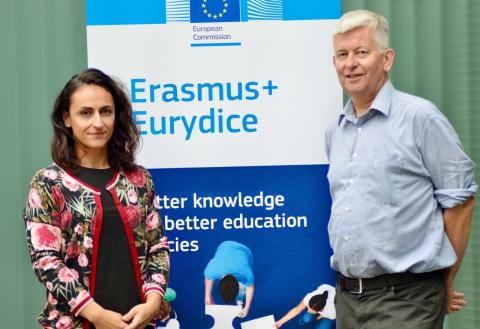How Member States are supporting Ukrainian refugee learners: Eurydice reports review policies and measures

Russia’s invasion of Ukraine forced many, including a large number of children and young people, to flee their home and search for protection in neighbouring European countries. In two reports published yesterday, the Commission’s Eurydice network gives a snapshot of the measures education authorities in Europe introduced to help schools and higher education institutions integrate refugee learners. Sogol Noorani and David Crosier from EACEA's Platforms, Studies and Analysis unit share with us their impressions.
What is Eurydice?
Eurydice is a network covering Erasmus+ countries (plus Albania, Bosnia and Herzegovina, Montenegro and Switzerland) whose task is to understand and explain how Europe’s different education systems are organised and how they work. We publish descriptions of national education systems and comparative studies devoted to specific topics in the field of education. National units in each country provide the policy information, indicators and statistics. We coordinate the network in EACEA and are responsible for gathering and analysing information in response to requests coming from DG EAC. Our common aim is to promote understanding, cooperation, trust and mobility across Europe.
What do these two reports explore? Why?
These reports are actually a voluntary activity for both EACEA and the network that we developed after our national units began exchanging information in March about measures that they were putting in place to support Ukrainian refugee learners. We decided to collect, analyse and organise the information to make it as comparable as possible. The reports investigate the key policies and measures put in place by top-level education authorities across Europe that aim to assist schools and higher education institutions in integrating and helping Ukrainian children and refugee learners.
We hope that this work will shed light on the educational reality in the immediate aftermath of Ukrainian refugees coming to Europe, and we hope that publishing the reports now in the summer will give an opportunity for national education systems to see what others are doing in Europe, and maybe be inspired by certain practice when planning the next school and academic year.
What is the situation in schools?
We see large differences between European countries in the number of children and young people who arrived from Ukraine and who are enrolled in schools. Reaching out to the families and ensuring that their children have access to education remains a priority.
We know that schools can be a place where newly arrived learners can feel safe, continue with their schooling and access many different types of support, including social and emotional support. Education systems across Europe have reacted rapidly with policies and measures to help schools in welcoming learners from Ukraine. Most countries also provide support for those children and young people who wish to follow the Ukrainian curriculum through distance learning; and they have created the necessary conditions so that schools can work with Ukrainian teachers.
Although the focus of all these initiatives remains on education, our report also highlights recent initiatives, for example teacher training and practical guidelines that have been issued to support the children and young people’s social and emotional well-being so that they can overcome the stress or trauma they may have experienced.

And in higher education?
The numbers of refugee students from Ukraine that have enrolled in higher education institutions appear so far to be relatively low: only Poland reports a significant number of enrolments (over a thousand) while no other country that collects data reaches a hundred. This may be because students have so far preferred to continue their Ukrainian higher education studies using online resources. However, most countries do not monitor the number of refugees in their higher education system, so data is often impossible to obtain. In any case, it is likely that there will be more significant numbers enrolling for the next academic year.
Most governments are supporting higher education institutions to be able to respond to particular needs of refugee learners from Ukraine. The most frequently found actions include language training, psychological counselling, academic guidance, introductory courses, and also reserving study places and providing financial support - mainly in the form of non-repayable grants.
Will your findings help to improve the situation?
Our reports identify and describe many positive measures from different countries. Our hope is that countries that may not yet be implementing some of these actions will be inspired to do so. We also see where there are some systemic problems in some countries – for example, lack of procedures to recognise learning and qualifications of refugees that cannot be documented – and we also point to smart and simple ways in which this can be remedied.
So holding up this European mirror will certainly do no harm, and hopefully it may help in some places. But of course, we recognise that what we are able to do here is just a drop in the ocean for Ukrainian refugees. On the other hand, without drops entering the oceans, where would we end up?
by József Barna, Commission en Direct
Links to the reports:
Supporting refugee learners from Ukraine in schools in Europe: https://eurydice.eacea.ec.europa.eu/publications/supporting-refugee-learners-ukraine-schools-europe-2022
Supporting refugee learners from Ukraine in higher education in Europe:
https://eurydice.eacea.ec.europa.eu/publications/supporting-refugee-learners-ukraine-higher-education-europe-2022
What is Lorem Ipsum?
Lorem Ipsum is simply dummy text of the printing and typesetting industry. Lorem Ipsum has been the industry's standard dummy text ever since the 1500s, when an unknown printer took a galley of type and scrambled it to make a type specimen book. It has survived not only five centuries, but also the leap into electronic typesetting, remaining essentially unchanged. It was popularised in the 1960s with the release of Letraset sheets containing Lorem Ipsum passages, and more recently with desktop publishing software like Aldus PageMaker including versions of Lorem Ipsum.




